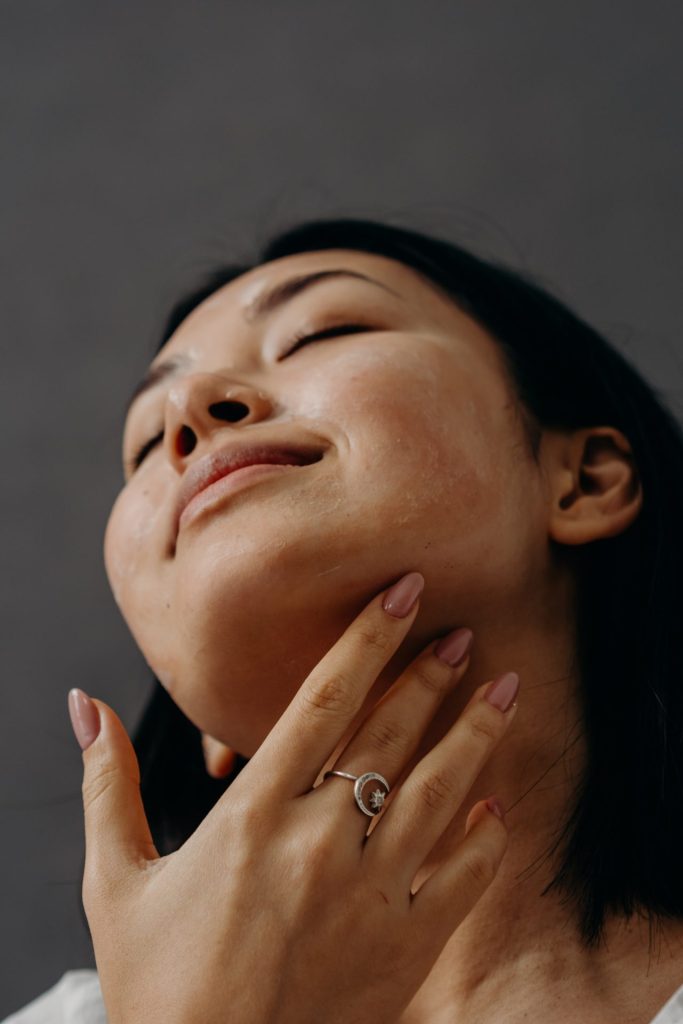It’s spring time!
Be it your mum’s genes or the weather where you live, the way your skin looks, feels, or behaves is usually a result of one thing or the other. Some reasons are within our control, some are not.
On hot/humid days your skin can feel moist, perhaps even uncomfortably moist. Making you want to look at facial masks, (anything to prevent outbreaks). But on cooler days, with that cold, crisp air, your skin could feel a little dryer. Making you turn to moisturizers.
However, in reality, it doesn’t really matter the weather. Dry or humid, hot or cold. How your skin acts the way it does could simply be what your skin type is. Dry, Oily, or Combination, and fun fact: this can change over time!
Knowing your skin type
Let’s go back a bit and return to the very first line of this article.
Okay no, the second “…genes”. Your skin type is primarily determined by genetics.
What are genes?
The gene is considered the basic unit of inheritance. Genes are passed from your parents to you, half from your mum, the other half from your dad, and contain all the information needed to specify physical and biological traits. Each gene carries its own set of instructions and determines things like height, hair and eye colour, and of course skin type.
However it is not all about genes. From a cosmetic point of view, skin type is classified according to three factors related to its balance. That is: Sebaceous secretion, Hydration and Sensitivity level.
- Sebaceous secretion: Sebaceous glands are microscopic glands found in your hair follicles that secrete sebum, an oily substance that protects your skin from drying out by providing a protective coating for your skin to help retain moisture.
- Hydration: According to Kim et al, there are six anatomical and physiological mechanisms that control skin hydration. They’re quite nerdy but we’ll list them out anyway. They are: skin surface pH, lipid bilayers, corneo-epidermal junction, natural moisturising factors (NMFs), hyaluronic acid and water transport proteins called aquaporins.
- Sensitivity level: Unlike the first two, when it comes to sensitivity, the much lower the better. This is because your skin’s primary function besides making you look stunning, is to protect the organs inside your body. So the stronger the fortress, the better.
On that note: Many argue that ‘sensitive’ is not a skin type, but rather a condition that occurs in association with your skin type, for example you can be both dry and sensitive or oily and sensitive skin.
Professor Greg Goodman divides the sensitive skin scale into three levels in order to make it easier to define and understand. Level 1- not sensitive, level 2 – mildly sensitive, level 3 – very sensitive. In other words, there are 3 main reasons why we feel sensitive.
The first occurs when your skin is introduced to an ingredient that over-stimulates it. In this case sensitivity is more likely to subside when your skin becomes used to it through gradual introduction. The second is caused by skin diseases such as rosacea or eczema. That’s where genes come into play yet again 😉 and the last reason is a true allergy. In which case a gradual introduction will not work in reducing sensitivity, so make sure you are not in contact with this trigger.
Based on these three characteristics, there are five types of healthy skin. Some of them are: dry, oily and combination (dry skin + oily skin), and as you probably know, each type has its own characteristics and requires different care.
What is combination skin
Simply put: Combination skin type is a mixture of dry and oily skin. If you have combination skin, some parts of your skin are dry and some parts of your skin is oily. It’s normal. There are many people who have this skin type that don’t know it. Yet they always seem like they don’t quite fall into either category of having oily skin or dry skin. We see you. You exist.
T-zones & Dry areas
What is a T-zone?
Your T-zone is made up of the ‘T’ shaped area spanning your forehead down to your nose and chin. Your T-zone contains more sebaceous glands than anywhere else on your face and so it is completely normal to appear more oily than other areas of your face. Especially when you have oily or combination skin.
What are dry areas?
Your dry areas are the parts of your skin that are most prone to dryness. On your face It is usually your eyelids and cheeks, and for some even the jaw and hairline.
So if you have a t-zone prone to oiliness and dry areas around your eyes down to your cheeks. Chances are: you have combination skin. See? It’s a thing!
How to care for combination skin
The secret to caring for combination skin properly is, you guessed it: balance. Just as both skin types co-exist in your temple of a body. It is important to strike a balance between ingredients that cater to both.
Some tips:
- Gentle products only
- Use clay masks
- Moisturizers are for you too
The perfect skincare routine for combination skin
Most people with combination skin fear that they might overdo it with some ingredients and underdo it with others. The first thing to do should be to eliminate that fear and understand that every skin care journey begins with a single step. That step is cleansing.
Cleansing
You want to begin by applying a clay face mask. A lot of people with combination skin and especially dry skin fear that face masks can be overly dehydrating. Naturally active ingredients including clay are combined with algae and botanical extracts, in Rí na mara cleansing face masks to deeply cleanse the skin, eliminate impurities and provide essential mineral hydration.
A few ways to use our clay face mask on combination skin include: avoid leaving it on for too long. A way to ensure this is by making sure it does not fully dry on your face. Also avoid using hot water to rinse off, instead use a soft cloth and lastly only once a week, unless in specific areas where you have outbreaks, then you can go twice a week.
Exfoliating
The next step in the routine is to exfoliate. Big word, we know. But it simply means to get rid of the dead skin cells on your skin’s surface. Some great exfoliating ingredients to look out for include: coffee grounds + brown sugar + buttermilk + honey or feamainn bhuí (a famous brown algae) Alpha-hydroxy acids (AHAs), Beta-hydroxy acids (BHAs) and retinol.
It might be useful not to try to ‘do it all’ during this step. Instead consider using exfoliating products for each and alternate which area you treat. For example: try a scrub on oily areas one day and a low-level AHA on dry areas the next.
Rí na mara dried seaweed soak bath can be left in the net bag and used to exfoliate all areas of combination skin. How? You ask. More on that below 😉
One of the most important reasons why exfoliating is so important for combination skin is because it allows your skin to really absorb the products, which will come handy in the last step.
Toning
Toners are skincare products that have consistency of water. They exist primarily to balance your skin’s pH. Rí na Mara micellar gentle cleansing water infused with precious marine & plant essences, doesn’t just take care of your T-zone but immerses your skin with proteins, vitamins & antioxidants to condition and preserve your dry areas’ natural moisture balance. Saturate a cotton pad with our cleansing water on every area of your face and neck. Once in the morning and twice at night. No need to rub or rinse.
Moisturising
When you begin the ‘moisturizing step’, it is important to use natural ingredients or gentle products only. The reason being the sensitivity level of your skin is more likely to spike up a bit after all that soft-core exfoliation.
Rí na Mara Intensive regenerating serum infused with organic marine and plant extracts immerses your skin with proteins, nutrients, and antioxidants that stimulate hydration, helping recharge your skin cells. Not to mention: naturally derived Hyaluronic acid that permeates the skin to help smooth fine lines, wrinkles and improve visible skin firmness.
Apply to face, neck and décolletage morning and evening after cleansing & exfoliating and massage gently. Follow with nourishing our Face Cream for ultimate softness.
Seaweed and combination skin
While reading this article, especially the bit about the combination skincare routine you might have noticed some ode to the sea with words like. “marine extracts”.
At Rí na mara Irish Seaweed Cosmetics, we harness the power of the sea and the natural environment to promote healthy, beautiful skin. Our unique range of beauty products is completely natural and are packed with the benefits of countless species of marine plants and algae that grow in the ocean. Benefits include vitamins A, B,C, D, and E, proteins, amino acids, and a rich collection of minerals, iron, calcium, and iodine.
But why is seaweed perfect for combination skin?
Because it does both!
Remember that thing we said earlier about balance? Well seaweed’s got you covered.
For your dry areas:
Seaweed is chock full of humectants and vitamin E, essential for your skin’s hydration and moisturisation. On top of that seaweed has incredible regenerative properties, stimulating natural hyaluronic acid & collagen synthesis, and encourages cell renewal.
For your T-zone:
Seaweed has an incredible ability to regulate oil production. We say ‘incredible’ because it does this by cutting down the oil film on your skin WITHOUT sucking out all the moisture. Also, due to its anti-inflammatory properties, it can help control breakouts in your T-zone. Need we say more?
In all the steps listed above, seaweed has been the secret ingredient all along. All Rí Na Mara products incorporate the purest natural ingredients from marine or plant origin and are suitable for combination and all skin types.
So if you’re a person of combined needs, what are you waiting for?













CONNECT WITH US